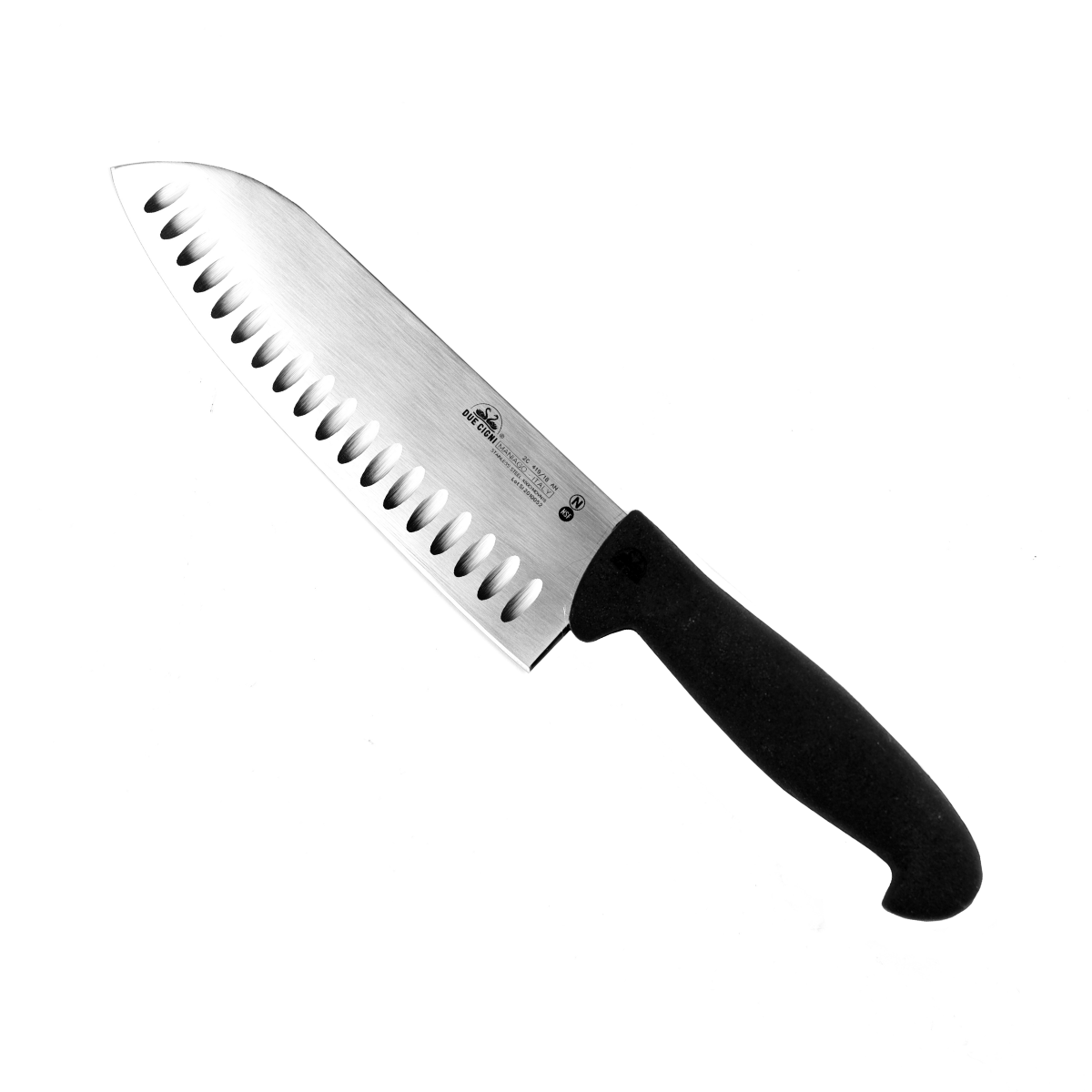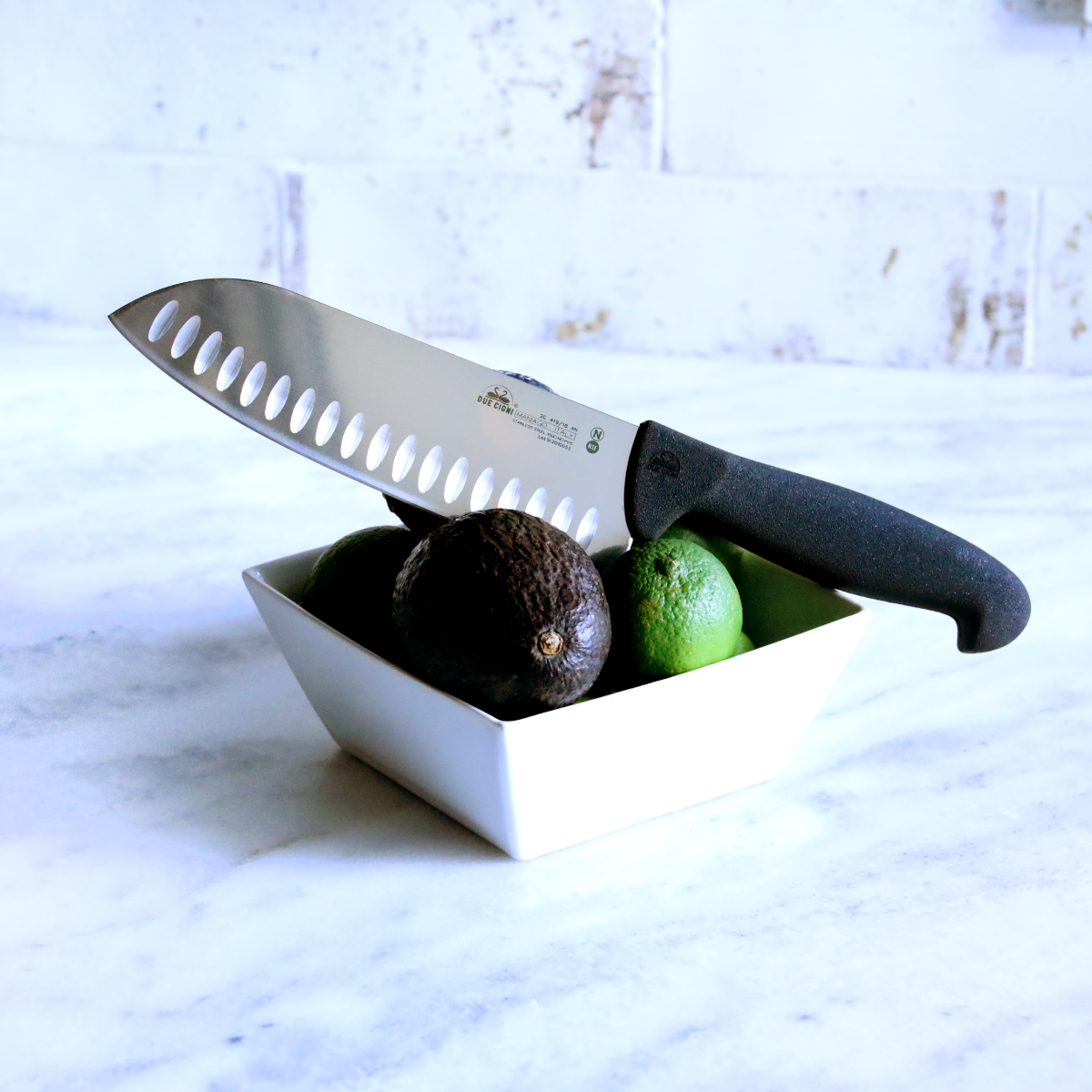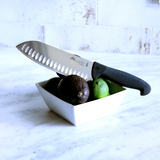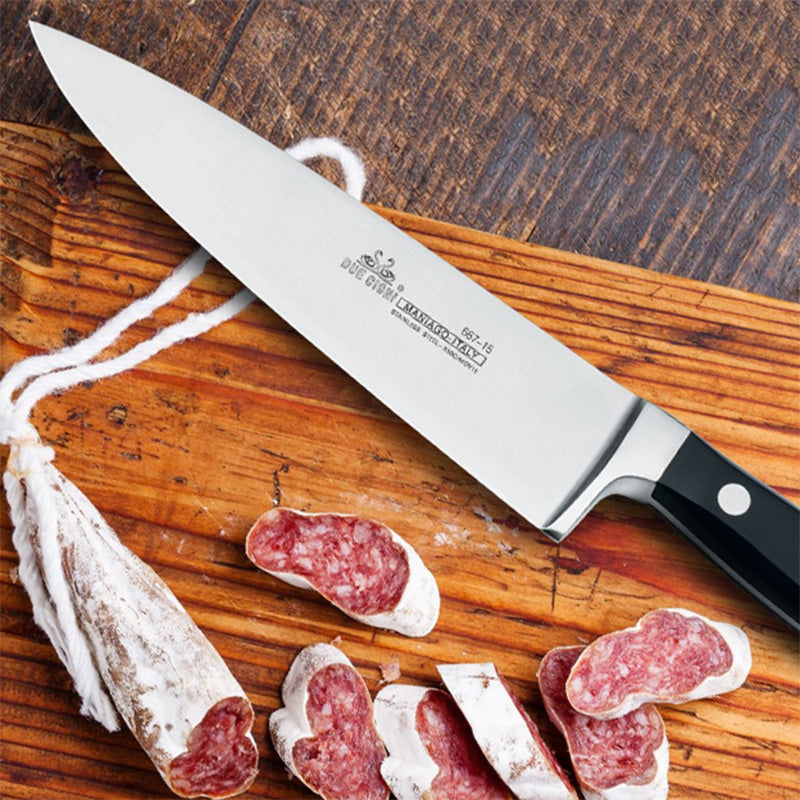7" Scalloped Santoku Knife
Black Handled Santoku Knife
DUE CIGNI PROFESSIONAL Santoku Knife 2C 419/18AN, professional kitchen knives, chef and butcher cutlery of stainless steel 4199 NitroB - HRC 55/57 - X50CrMoVN15 of high quality - Granton Edge Blade length 7.1" - Nylon handle a very resistant and durable plastic material suitable for washing in the dishwasher - Available in two colors Black or Yellow - DUE CIGNI professional chef knife, a truly exceptional product with quality materials, great cutting capacity and cutting edge strength and an excellent design, guarantee of professionalism in your kitchen.
The scallops on this knife help it release food as you slice. If you need really thin cuts you should use Due Cigni’s santoku knife rather than Due Cigni’s chef knife. Due Cigni’s 7” Full Tang Santoku Knife with Scallops is best for cutting meats, slicing cheese, and slicing, chopping or dicing fruits, nuts, and vegetables. Santoku means “three virtues”; slicing, dicing, and chopping.
What is a scalloped Santoku knife used for?
A scalloped Santoku knife, featuring small indentations (scallops) along the blade, is designed to reduce friction and prevent food from sticking. These indentations create air pockets, making it ideal for slicing through sticky or starchy foods like potatoes and cheese. The scallops also reduce drag when cutting through meats, allowing for smoother and more precise slicing motions. The design enhances the knife's non-stick properties, making it a versatile tool for various kitchen tasks, particularly those involving slicing, dicing, and chopping.
Click To Read All FAQS
What are the ridges on a Santoku knife for?
The ridges, or kullens, on a Santoku knife are designed to reduce friction and prevent food from sticking to the blade. They create small air pockets that help food slide off the knife more easily, making it particularly effective for slicing, dicing, and chopping. The kullens also reduce drag when cutting through fruits, vegetables, or boneless meats, contributing to a smoother and more efficient cutting experience. While not all Santoku knives have ridges, those that do enhance the knife's non-stick properties and make it well-suited for various kitchen tasks.
What is a scalloped knife used for?
A scalloped knife, often featuring small indentations (scallops) along the blade, is designed to reduce friction and prevent food from sticking. These indentations create air pockets, making the knife ideal for slicing through sticky or starchy foods like cheese and potatoes. The scallops also minimize drag when cutting through meats, facilitating smoother and more precise slicing motions. The design enhances the knife's non-stick properties, making it versatile for various kitchen tasks, particularly those involving slicing, dicing, and chopping.
What is the purpose of the divots on a Santoku knife?
The divots, or grantons, on a Santoku knife serve to reduce suction and prevent food from sticking to the blade. These small indentations create air pockets, allowing for smoother slicing and chopping of ingredients. The grantons also minimize drag, making the knife well-suited for precision tasks like thinly slicing vegetables, fruits, and boneless meats. While not all Santoku knives have divots, those that do enhance the knife's non-stick properties, contributing to improved performance in the kitchen.
Can you use a Santoku knife for everything?
While Santoku knives are versatile and excel at slicing, dicing, and chopping, they may not be ideal for heavy-duty tasks like butchering meat with bones. Their shorter, thinner blades may lack the heft needed for certain tasks. While suitable for many kitchen activities, a Santoku knife might not replace the need for other specialized knives, like a cleaver or a boning knife, in a well-equipped kitchen. Ultimately, it depends on individual preferences and cooking habits, but having a variety of knives ensures you have the right tool for every culinary task.
Do chefs use Santoku knives?
Yes, many chefs use Santoku knives in professional kitchens. Santokus are valued for their versatility in slicing, dicing, and chopping, making them suitable for a variety of tasks. The knife's Japanese design, sharpness, and ergonomic features are appreciated by chefs. However, while popular, the choice of knives varies among chefs, and some may prefer other styles, such as chef's knives, depending on their culinary needs.
Can Santoku knife cut potatoes?
Yes, a Santoku knife is well-suited for cutting potatoes. The knife's design, with a sharp, flat edge and slightly curved belly, makes it effective for slicing, dicing, and chopping a variety of ingredients, including potatoes. The Santoku's thin and sharp blade allows for precision cuts, and if the knife has grantons (small indentations), it helps reduce friction and prevent the potatoes from sticking to the blade. Whether you're making fries, hash browns, or diced potatoes, a Santoku knife can be a versatile tool for potato preparation in the kitchen.
Is Santoku knife same as chef's knife?
While both Santoku and chef's knives are versatile kitchen tools, they have key differences. Santoku knives, of Japanese origin, typically have a shorter, thinner blade with a flat edge and are well-suited for slicing, dicing, and chopping. Chef's knives, often of Western origin, have a longer, broader blade with a curved edge, providing a rocking motion for chopping. Chef's knives are more multipurpose and excel in tasks like mincing and disjointing meat. Ultimately, the choice between a Santoku and a chef's knife depends on personal preference, cutting style, and the tasks at hand.
What foods do you cut with a Santoku knife?
It's ideal for fruits like tomatoes, melons, and citrus, as well as vegetables such as onions, peppers, and leafy greens. The knife's precision makes it suitable for herbs and garlic. Santokus effortlessly handle boneless meats, making them a choice for slicing chicken, pork, or beef. While proficient with seafood, it may not be the best for heavy-duty tasks like breaking down poultry with bones.
Are Santoku knives good for cutting vegetables?
Santokus are particularly well-suited for tasks like chopping onions, slicing tomatoes, and julienning carrots. The versatility of a Santoku knife makes it a popular choice for handling a variety of vegetables with ease, making it a valuable tool in the kitchen for those who frequently prepare salads, stir-fries, or other vegetable-centric dishes.
Can you cut bread with a Santoku knife?
While a Santoku knife can cut bread, it's not the most ideal choice. Santokus have thin, straight blades, lacking the serrations found on dedicated bread knives. Serrated edges are designed to saw through crusty bread without crushing it, whereas Santoku knives may compress the bread, affecting its texture. If a bread knife is unavailable, a serrated knife or even a chef's knife with a gentle sawing motion can be more effective for achieving clean slices without compromising the bread's integrity.
What are the three virtues of a Santoku knife?
The three virtues of a Santoku knife, as reflected in its name, are slicing, dicing, and chopping. "Santoku" translates to "three virtues" or "three uses" in Japanese, emphasizing the knife's versatility in these fundamental kitchen tasks. The blade's design, featuring a sharp, flat edge and a slightly curved belly, enables efficient slicing, while the overall shape allows for precise dicing and chopping motions.
Is a Santoku knife a butcher knife?
No, a Santoku knife is not a butcher knife. While both are versatile, they serve different purposes. A Santoku knife has a shorter, thinner blade with a flat edge, ideal for slicing, dicing, and chopping fruits, vegetables, and boneless meats. In contrast, a butcher knife has a larger, heavier blade designed for heavy-duty tasks like breaking down meat, disjointing poultry, and trimming fat. Butcher knives excel in tasks requiring force and precision, making them distinct from the more nimble and precise Santoku knife, which is better suited for finer cuts in the kitchen.
Blade Steel: stainless steel 4116 X50CrMoV15
Hardness: HRC 55-57
Blade Coating: satin
Handle: black POM
Rivets: stainless steel
Blade Length: 18 cm – 7.09″
Overall Length: 30 cm – 11.81″
Blade Thickness: 2 mm – 0.08″
SHIPPING
Most orders will be processed within one business day (we make sure our employees take Saturday and Sunday off, so if you order late Friday or over the weekend, we will process your order on Monday). When your order leaves our warehouse in Seattle, Washington, you will receive an email with your tracking number. Add 3 to 5 business days for delivery. Please note that we only ship within the United States.
RETURNS POLICY
We take pride in our workmanship and stand behind our products, which is why we accept returns within the first 30 days from the day your items arrive.
Collections
Products
Blogs





 7" Scalloped Santoku Knife
7" Scalloped Santoku Knife
 7" Scalloped Santoku Knife with fruit
7" Scalloped Santoku Knife with fruit


 DueCigni Cutlery
DueCigni Cutlery

 DueCigni Cutlery
DueCigni Cutlery